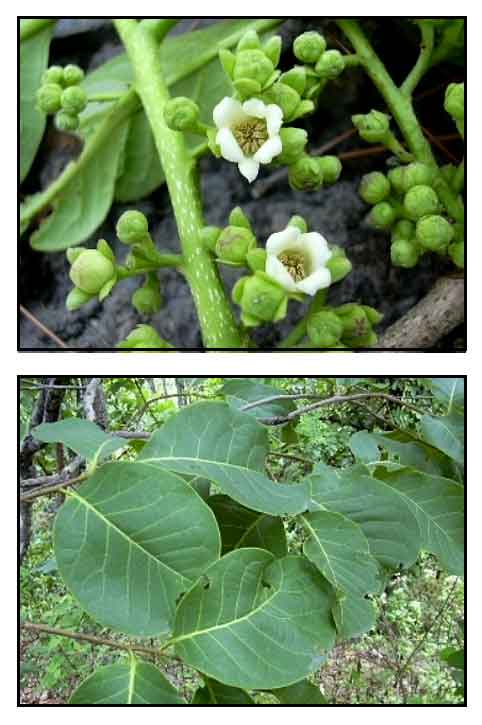 Gen info Gen info
Diospyros is a genus of over 700 species of deciduous and evergreen trees and shrubs. The majority are native to the tropics. Some are values for thei hard, dark, and heavy timber; others valued for fruits; some used as ornamentals.
Botany
Diospyros ehretioides is a deciduous tree with a spreading crown, growing to a height of 16 meters, with a trunk up to 150 centimet4rs. Petioled are about 1 centimeter. Leaf blade is oblong-elliptic to elliptic.8 to 20 by6.5 to 9 centimeters, leathery, baxiallu pubescent and denser in the middle,adaxially pbescent, glabrescent except for hairs along th midrib, base broadly cuneate to rounded; apex acute to rounded, lateral veins 6 to 10 per side, reticulate veinlets lax, slender, and raised on both surfaces Male flowers are in 3-flowered cymes, usually on current year's branchlets, small; calyx brownish villose, lobes 4; corollat about twice as long as the calyx.. Female flowers in pedunculate cymes, pedicels much shorter than peduncle, often only one forming fruit.. Fruiting calyx deeply divided, 1.5 to 1.8 centimeters i diameter, lobes some eventualy strongly reflexed, about 7 by 6 millimeters, often unequal, pubescent. Fruits are globose berries, up to 3.5 centimeters in diameter. Seeds are compressed, oblong, about 1.5 centimeters, endosperm ruminate. (9)
Distribution
- Introduced.
- An understorey tree in dense to open forets or slopes
-
in southern China. India, Myanmar, Thailand, Cambodia.
(6)
Constituents
- Study of dried fruits isolated deoxypreussomerin derivatives, palmarumycins JC1 (1) and JC2 (2), and two dimeric naphthoquinones, isodiospyrin (3) and its new derivative isodiosprol A (4). (see study below) (2)
- Study of stems isolated a new a new (naphthalenyl) methyl acetate, (1,4,5-trimethoxynaphthalen-2-yl)methyl acetate (1) and (±)-4,5-dihydroxy-2-methyltetralone (2) were isolated together with five lupane triterpenes (3–7), naphthoquinone derivatives (8–13), coumarins (14 and 15) and a vanillic acid (16). (see study below) (3)
- Preliminary phytochemical screening of air-dried stem bark yielded flavonoids, terpenoids, steroids, glycosides, reducing sugars, lipophilics, polyphenols, tannins, and phenolic compounds. An isolated compound (1) was identified as lupeol. (4)
Properties
- Studies have suggested antimalarial, antimycobacterial, cytotoxic, antifungal properties.
Parts used
Fruits and stems.
Uses
Folkloric
- No reported medicinal use in the Philippines.
In Thailand, a component in herbal formulations for asthma (macerated mixture of D. ehretioides, Memecyclon scutellaum, and Rothmannia wittii) and alimentary bleeding and inflammation (decoction of D. ehretioides and Cassia siamea). (5)
Others
- Wood: Wood is moderately hard, even-grained, dark gray, with darker streaks, sometimes handsomely mottled. Used for house posts. (6)
Studies
• Bioactive Deoxypreussomerins / Antimalarial / Antimycobacterial / Antifungal / Cytotoxic / Dried Fruits: Study of dried fruits isolated deoxypreussomerin derivatives, palmarumycins JC1 (1) and JC2 (2), and two dimeric naphthoquinones, isodiospyrin (3) and its new derivative isodiosprol A (4). The palmarumycins were not found in fresh fruit extracts, which suggests the palmarumycins JC1 and LC2 were more likely fungal metabolites, i.e., endophytes or epiphytes. JC2 exhibited antimalarial, antifungal, antimycobacterial, and cytotoxic activities. Isodiospyrol A (4) exhibited antimalarial and antimycobacterial activites. Compound 4 exhibited cytotoxicity against BC cells but not towards KB and Vero cell lines. (2)
• Cytotoxicity Against Cancer Cell Lines / Stems: Study of stems isolated a new a new (naphthalenyl) methyl acetate, (1,4,5-trimethoxynaphthalen-2-yl)methyl acetate (1) and (±)-4,5-dihydroxy-2-methyltetralone (2) were isolated together with five lupane triterpenes (3–7), naphthoquinone derivatives (8–13), coumarins (14 and 15) and a vanillic acid (16). Compounds 1 and 2 showed significant cytotoxicity against three cancer cell lines, HeLa, HCT116, and MCF-7 with IC50s in the range of 5.05-15.90 µg/mL, while compound 16 showed cytotoxicity against HeLa and HCT116 cells lines but no toxicity to Vero cells. (3)
Availability
- Wild-crafted.
|

![]()



 Gen info
Gen info